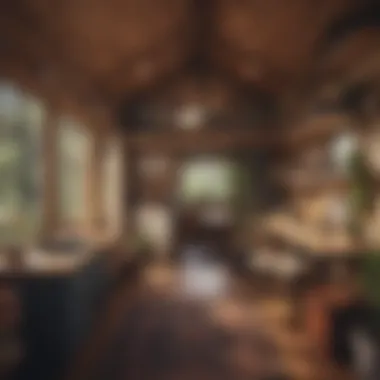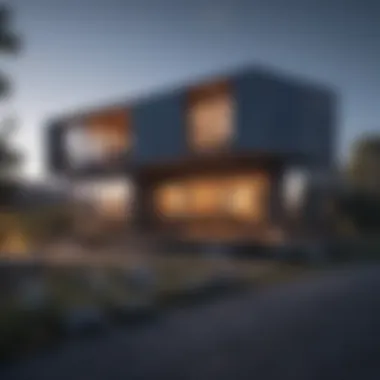Exploring Alternative Living Spaces for Rent


Intro
The rental landscape has evolved significantly, presenting individuals with a variety of choices beyond conventional apartments or houses. This change aligns with the increasing desire for unique and personalized living experiences. Alternative living spaces cater to diverse lifestyles, reflecting trends in social behavior, sustainability, and design preferences. Understanding these alternatives becomes essential for renters seeking to make thoughtful decisions.
In this article, we will explore various aspects of unconventional accommodations, examining their features, advantages, and challenges. We will delve into distinct housing options, illuminating their key characteristics. This exploration serves not only to inform but also to inspire those looking to embrace a different kind of living situation.
Home Features
Architectural Marvels
Many alternative living spaces possess remarkable architectural designs, often characterized by creativity and functionality. Think of tiny homes, portable cabins, or shipping container residences. Each of these options showcases innovative use of space, maximizing utility without sacrificing aesthetics. For renters who value sustainability, an eco-friendly architectural design provides both a practical and ethical choice.
Considerations when looking at architectural marvels include:
- Space Efficiency: Key in small living environments.
- Materials Used: Can range from repurposed materials to modern composites.
- Environmental Impact: Many structures utilize sustainable practices.
Unique Design Elements
Alongside architecture, design elements play an important role in defining alternative living spaces. These elements can turn a simple accommodation into an inviting and stylish home. Most alternative rentals offer unique personalization options, making it easier for renters to express their individual tastes. Here are some notable design features to consider:
- Open Floor Plans: Common in tiny homes and lofts, enhancing the feeling of space.
- Natural Light: Large windows or skylights greatly influence the ambiance.
- Innovative Storage Solutions: Cleverly designed furniture pieces to maximize space.
Design can elevate the living experience, transforming a space into a haven suited to one’s lifestyle. Each design choice contributes to an overall atmosphere, impacting mood and practicality.
"Understanding architectural and design choices is crucial for renters who value aesthetics and efficiency."
Interior Design Inspirations
Color Palettes and Themes
To enhance the mood of alternative living spaces, choosing the right color palette is important. Colors influence how we perceive space and affect our emotions. Soft tones create calmness, while bold colors can energize a space. Examples of effective themes include:
- Minimalist: Focus on simplicity with neutral colors.
- Bohemian: Combine vibrant hues with eclectic decor.
- Industrial: Use earthy tones and raw materials for a modern look.
Furniture Arrangement Tips
In smaller spaces, furniture arrangement becomes critical. Efficient layout facilitates movement and maximizes area for functionality. Consider:
- Multi-Functional Furniture: Pieces that serve more than one purpose.
- Zoning: Create distinct areas for different activities.
- Decluttering: Maintaining an uncluttered space ensures it feels larger and more inviting.
Understanding how to furnish and decorate in a way that complements the unique attributes of these spaces adds significant value. It encourages renters to embrace their alternative living situations fully.
Foreword to Alternative Living Spaces
As urbanization progresses, the need for diverse and flexible living arrangements becomes increasingly relevant. Alternative living spaces provide innovative options that cater to various lifestyles and preferences. The significance of this topic lies in its potential to reshape the way people view housing. Such accommodations can fit different budgets and personal tastes, encouraging creativity and environmental sustainability. Choosing alternative rentals can also lead to unique experiences, often unattainable in traditional settings.
Defining Alternative Living Spaces
Alternative living spaces encompass a range of unconventional housing options that diverge from standard single-family homes or apartments. This includes, but is not limited to, tiny homes, houseboats, and converted shipping containers. Each type offers distinct characteristics, often blending functionality with affordability. For instance, many of these options emphasize minimalism and sustainable living. This definition acknowledges a growing movement aimed at more intentional living, allowing individuals to align their homes with their values.
The Rise of Alternative Living
The rise of alternative living spaces can be attributed to several socio-economic factors. Many young professionals, retirees, and environmentally-conscious individuals are looking for unconventional rental options. A significant rise in remote work allows people to choose locations that suit their lifestyle rather than being tied to traditional job centers. Moreover, high housing costs are prompting a shift towards more affordable living arrangements. This trend is often enhanced by a desire for community and connection. Thus, the evolution of this segment responds not only to practicality but also to an emerging cultural fabric that values experiences over possessions.
"Alternative living spaces signify a departure from convention, honoring personal expression while addressing modern challenges in housing."
Individuals exploring these living options should consider various factors. Geographic location, local regulations, and personal lifestyle preferences are crucial in making informed decisions about alternative rentals.


Types of Alternative Living Spaces
The concept of alternative living spaces has gained momentum over recent years. This section will illuminate various types of unconventional accommodations. Each type comes with its own set of advantages and challenges. Identifying the available options can enhance your living experience significantly. This exploration of different living spaces allows potential renters to make informed decisions based on unique needs and preferences.
Tiny Homes
Design and Functionality
Tiny homes are notable for their efficient design. The layout often maximizes space with multifunctional furniture. For example, beds can fold away, and tables can extend or condense. This characteristic makes tiny homes a practical choice for minimalists or those keen on decluttering their lives. The cost savings from reduced utilities and maintenance are appealing aspects. However, the limited space can feel restrictive for some, especially families or those used to larger homes.
Cost Considerations
Affordability is a key advantage of tiny homes. Generally, the initial cost to build or rent a tiny home is lower than that of a traditional residence. Lower utility bills add to the overall cost-saving potential. However, hidden expenses may arise during relocation or customization. Understanding these costs is essential before committing. An additional downside can be the need for careful budgeting to ensure that unexpected costs do not arise.
Living Off the Grid
Living off the grid is an exciting component associated with tiny homes. Many tiny home renters opt for solar panels and composting toilets. This choice promotes self-sufficiency and reduces dependence on public utilities. It aligns with a growing trend toward sustainable and eco-friendly living. Still, living off the grid may involve challenges. Access to food, water, and healthcare can be less convenient compared to urban environments.
Houseboats
Living on Water
Houseboats offer a distinctive lifestyle on water. They provide unique scenic views and a tranquil environment. Renting a houseboat can feel like a vacation while living at home. The appeal lies in the novelty and connection to nature that houseboats foster. However, these spaces may present challenges such as limited space and specialized maintenance needs due to exposure to the elements.
Community Aspects
Living on houseboats can lead to strong community bonds. Many houseboat residents form a close-knit community, often shared by fellow boat dwellers. This aspect can be comforting and encouraging during transitions or life changes. However, individuals who prefer solitude or quiet environments might find this communal living unsuitable.
Maintenance Challenges
Regular maintenance is paramount for houseboats. The marine environment can lead to issues like mold and boat rot. Renters need to understand these maintenance needs upfront. Failure to address them can lead to costly repairs. Despite the charm of living on water, potential renters should weigh these responsibilities carefully.
Converted Shipping Containers
Use in Urban Areas
Converted shipping containers have emerged as versatile housing options in urban spaces. They utilize existing materials effectively and fit well into limited city landscapes. Their portability allows for new housing developments to be created in unconventional areas. Nevertheless, a potential downside includes zoning restrictions that can complicate the setup.
Environmental Impact
The environmental benefits of using shipping containers are significant. Repurposing materials reduces waste and encourages sustainability. Their construction requires fewer resources compared to traditional buildings. However, the environmental impact can vary based on how the container is modified and energy sourced. It is crucial for renters to consider these factors.
Interior Design Options
The interior of shipping containers can be customized significantly. They can be transformed into stylish living spaces with modern finishes. Options include open-plan designs or partitioned rooms to fit preferences. The challenge is ensuring that insulation and ventilation are well-planned for comfort. Without attention to these elements, the interior may become uncomfortable during extreme temperatures.
Yurts and Dome Homes
Structural Benefits
Yurts and dome homes are structurally sound, thanks to their circular designs. This design provides strength against harsh weather conditions. They offer spacious interiors while maintaining a small footprint. Such homes can be ideal for ecological living or off-grid situations. Still, building codes and insulation requirements should be checked before opting for these types.
Climate Adaptability
These living spaces are often adaptable to various climates. Yurts can be used in both hot or cold regions, maintaining temperature efficiently. Dome homes can naturally shed snow, making them suitable for wintery climates. However, their effectiveness will rely on proper construction methods and site selection, which is essential to maximizing their benefits.
Experience of Living
The experience of living in a yurt or dome home can be unique and enriching. They often create a close connection with nature. They also facilitate mindfulness by minimizing distractions. Nonetheless, some may find these unconventional homes isolating, especially if they are far from urban conveniences.


Co-living Spaces
Community Living
Co-living spaces promote a community-oriented lifestyle. They often include shared amenities such as kitchens and recreational areas, encouraging interaction among residents. This setup fosters connections that can lead to meaningful relationships. However, those who prefer privacy may find shared living arrangements challenging.
Affinity Groups
Affinity groups within co-living spaces can enhance the living experience. These communities often form based on shared interests, such as sustainability or technology. Such groups foster deeper connections among residents. Yet, the effectiveness of these communities relies on the willingness of individuals to participate and share experiences.
Flexibility and Socialization
A primary feature of co-living is flexibility. Lease terms can be shorter, allowing renters to adapt their living situations based on changing needs. This flexibility can be advantageous for those transitioning in life or work. However, frequent changes in residents can disrupt the sense of stability some may seek.
Benefits of Alternative Rentals
Alternative living spaces offer advantages that transcended that of traditional rental homes. This section elaborates on facets such as affordability, unique experiences, and sustainability.
Affordability
Renting alternative living spaces can often be more economical than conventional homes. The cost of living has been increasing, making it challenging for many individuals to find suitable housing. Renting a tiny home, a converted shipping container, or even a houseboat can provide significant savings. Often, these locations require lower monthly rents, which can alleviate financial burdens for tenants.
Additionally, expenses such as utilities may be reduced due to smaller square footage. For instance, many tiny homes are designed for energy efficiency. Renters may find that they can live comfortably without high costs, benefitting their overall financial health.
Unique Experiences
Choosing alternative rentals also means embracing unique lifestyles and environments. Living in a yurt or a houseboat is not simply about changing the physical space; it creates an entirely different atmosphere and lifestyle. Experiencing diverse cultural settings can expand one’s perspective and lead to personal growth.
People often seek these accommodations for the distinctive experiences they provide, such as stunning views, serene environments, or a new sense of community. A yurt nestled in nature offers tranquility, while living on a boat can provide a unique sense of adventure.
"Alternative living spaces allow you to explore lifestyles that conventional homes cannot offer."
Sustainability
Sustainability is a major draw for many people opting for alternative rental spaces. Many of these homes utilize eco-friendly materials and have lower carbon footprints. Tiny homes, for example, are often built with sustainability in mind, incorporating features such as solar panels and composting toilets. This focus on environmental responsibility can resonate deeply with renters who value sustainable living.
Moreover, alternative residences tend to encourage minimalism. Occupants are less likely to accumulate excess belongings, thus promoting a cleaner lifestyle that uses less resources. In this way, renting alternative spaces can reflect a responsible attitude towards consumption and living, contributing positively to the environment.
With the growing importance of sustainable practices, choosing to rent alternative spaces aligns with contemporary values.
Overall, the benefits of alternative rentals position them as appealing options for many individuals and families. By considering affordability, unique experiences, and sustainable living, potential renters can find solutions that suit their needs.
Considerations Before Renting
When it comes to alternative living spaces, several considerations must be kept in mind before finalizing a rental agreement. This section explores those elements thoroughly, weighing their benefits and impacts. Understanding these factors can significantly influence the overall experience and satisfaction with the chosen living arrangement.
Legal Regulations
Legal regulations surrounding alternative living spaces vary widely depending on local laws and property types. These rules can affect zoning, rental agreements, and even the type of modifications one can make to the space. For instance, tiny homes might face restrictions in certain areas, while houseboats have their own set of maritime laws. It is crucial to verify that the rental complies with all local regulations to prevent future legal disputes.
Not adhering to legal requirements can lead to fines or eviction. Thus, researching local building codes and occupancy laws is an important step in the process of renting an unconventional living space.
Insurance and Liability
Insurance considerations are pertinent when renting alternative living accommodations. Standard renter's insurance may not cover certain risks associated with unique properties. For instance, living on a houseboat might require specific marine insurance, while renting a tiny home may necessitate additional coverage for the unique structural features.
Liability is another aspect. If an accident occurs, understanding where liability falls is essential. Always communicate with the owner about what is covered under the rental agreement. It ensures both parties are aware of their responsibilities, preventing misunderstandings later.


Practicalities of Space
Understanding the practicalities of the space is vital for enjoying the alternative rental experience. Renters should consider several elements before signing a lease.
Size and Layout
The size and layout of a living space can significantly influence daily life. In many alternative rentals, especially tiny homes and yurts, space is limited. A well-thought-out layout maximizes functionality and enhances livability.
Many individuals are drawn to smaller living spaces because they promote a minimalist lifestyle. However, it can also lead to challenges like limited storage and cramped conditions. It is advisable to evaluate how your lifestyle fits within the confines of the available space.
Accessibility
Accessibility is another critical aspect. Alternative living venues may not have the same level of access as traditional homes. For instance, a rental unit on a houseboat may be challenging for individuals with mobility issues.
Assessing how accessible a property is can help avoid frustration during your stay. Make note of stairs, ramps, or narrow passages that could impede comfortable living. Choosing a rental that aligns with your accessibility needs ensures a positive experience.
Facilities and Amenities
Finally, the availability of facilities and amenities can greatly enhance or hinder the living experience. Some alternative rentals might not offer equipped kitchens or laundry facilities. Understanding what is included in the rental is essential for practical living.
For example, some co-living spaces come fully furnished and maintain shared amenities, providing social interaction and convenience. In contrast, others may not have such facilities, requiring renters to adjust their expectations accordingly.
Finding Alternative Living Spaces
Finding alternative living spaces is crucial for those looking to explore housing options beyond the conventional. This topic investigates how modern renters seek out unique environments that align with their values, lifestyles, and budgets.
Alternative living spaces often reflect a desire for sustainable living, community engagement, or simply a new experience. With the emergence of online platforms and specialized real estate agents, the search process has become more accessible and diverse.
Online Platforms
Rental Marketplaces
Rental marketplaces serve as centralized hubs where landlords and potential tenants can connect. These platforms, such as Airbnb and Vrbo, simplify the process of finding alternative living spaces. They offer a variety of listings ranging from tiny homes to houseboats. One key characteristic of rental marketplaces is user-generated content, which includes reviews and ratings from previous renters. This transparency allows potential renters to make informed decisions.
The unique feature of rental marketplaces is their ability to cater to diverse preferences and budgets, making it easy for users to filter options based on their needs. For example, filters for price, location, and type of accommodation help streamline the search. However, some renters may find that the fees can be higher compared to traditional leasing.
Social Media Groups
Social media groups provide an informal yet effective option for finding alternative rentals. Platforms like Facebook host various groups dedicated to unique housing options or specific geographical areas. The key characteristic of these groups is their community-driven approach, where members share listings and personal experiences. This can foster a sense of trust and connection between renters and property owners.
A unique aspect of social media groups is their immediacy and real-time interaction, allowing potential renters to ask questions and receive answers from within the community. Unlike structured rental platforms, social media groups may have less regulation and oversight, which can lead to both opportunities and risks in the renting experience.
Real Estate Agents Specialized in Alternative Living
Working with real estate agents who specialize in alternative living spaces is advantageous for anyone looking to navigate this niche market. These agents understand the specific needs associated with unique rentals and can provide valuable insights into the market trends.
A major benefit of utilizing specialized agents is their access to hidden or off-market opportunities that may not be available through traditional channels. They can offer tailored advice and use their network to connect clients with suitable options more efficiently. However, working with an agent may incur additional costs, so it is essential to weigh these considerations against potential time and effort savings.
Ending
As we have explored the different aspects of alternative living spaces, it becomes clear that this topic holds significant relevance in today's housing landscape. Renting unconventional homes not only opens up new possibilities for living arrangements, but it also strengthens the connection between individuals and their environments. With increasing housing costs and shifting societal priorities, many people are seeking more affordable and meaningful options.
Future of Alternative Living Spaces
The future of alternative living spaces seems promising as the demand continues to grow. With advances in design and technology, these spaces are becoming more livable and appealing. Innovations like prefabricated homes and eco-friendly materials contribute to the sustainability wave. Many regions have begun embracing these homes through relaxed zoning regulations, making it easier for people to rent them.
Furthermore, the rise of remote work has transformed living preferences. More individuals are looking for unique locations to enhance their work-life balance. Options like tiny homes and converted shipping containers in scenic areas are being favored. As a result, rental platforms are increasingly catering to this trend, showcasing various unique options. This diversity enhances the overall rental market, making it vital for potential renters to stay informed.
Final Thoughts on Renting Unconventional Homes
Renting unconventional homes can significantly enrich one’s living experience. Such arrangements often foster a sense of community and connection to nature. People who choose alternative living spaces often report greater satisfaction in their daily lives compared to traditional settings.
Key considerations include practical issues like space constraints, local regulations, and insurance matters, which cannot be overlooked when transitioning to these living styles.
In summary, alternative rentals present a viable path for individuals seeking a unique housing experience. They challenge conventional views on living and prompt a reevaluation of what home can mean. As society progresses, embracing these options could lead to more sustainable and fulfilling living conditions.



